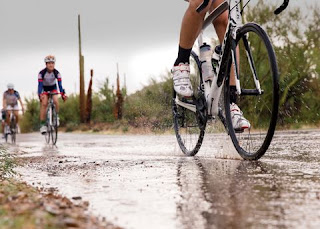My daily commute takes me through Randall's Island. It's a bit like riding through a large park, as much of the island consists of athletic fields and gardens.
One thing about it is frustrating, though. There are pedestrian/bike paths on the island, but they are not connected. That means, for example, that when you descend from the RFK Bridge ramp, you could find yourself hurtling straight into the path of a bus or Parks Department maintenance truck because the path at the end of the ramp runs for a couple hundred meters before ending abruptly on the island's street. And it's easy to miss the turn to get onto the path that leads to the Randall's Island Connector, the bike/pedestrian bridge that links the island to the Bronx.
Also, cycling is not allowed on the fields or, understandably, in the gardens. So it's difficult, if not impossible, to go from, say, the 103rd Street pedestrian bridge to the Connector.
Well, it looks like at least one step is being taken to make the island more navigable for cyclists and pedestrians. The Randall's Park Alliance has announced that it's received a grant for a new pathway to connect Sunken Garden Fields with the waterfront pathway by the 103rd Street Bridge.
While this will be a boon mainly to people living in (or cycling from) Manhattan, it is at least one link in what could become a system of paths that will allow more traffic-free access to more of the island.
What is needed, along with that path, is one that transverses the island and allows cyclists and pedestrians exiting the Queens or Manhattan spurs of the RFK Bridge to access the Connector, and the eastern part of the island, without having to contend with buses and trucks barreling down, or traffic exiting the bridge.
One can hope...
One thing about it is frustrating, though. There are pedestrian/bike paths on the island, but they are not connected. That means, for example, that when you descend from the RFK Bridge ramp, you could find yourself hurtling straight into the path of a bus or Parks Department maintenance truck because the path at the end of the ramp runs for a couple hundred meters before ending abruptly on the island's street. And it's easy to miss the turn to get onto the path that leads to the Randall's Island Connector, the bike/pedestrian bridge that links the island to the Bronx.
Also, cycling is not allowed on the fields or, understandably, in the gardens. So it's difficult, if not impossible, to go from, say, the 103rd Street pedestrian bridge to the Connector.
Well, it looks like at least one step is being taken to make the island more navigable for cyclists and pedestrians. The Randall's Park Alliance has announced that it's received a grant for a new pathway to connect Sunken Garden Fields with the waterfront pathway by the 103rd Street Bridge.
While this will be a boon mainly to people living in (or cycling from) Manhattan, it is at least one link in what could become a system of paths that will allow more traffic-free access to more of the island.
What is needed, along with that path, is one that transverses the island and allows cyclists and pedestrians exiting the Queens or Manhattan spurs of the RFK Bridge to access the Connector, and the eastern part of the island, without having to contend with buses and trucks barreling down, or traffic exiting the bridge.
One can hope...

